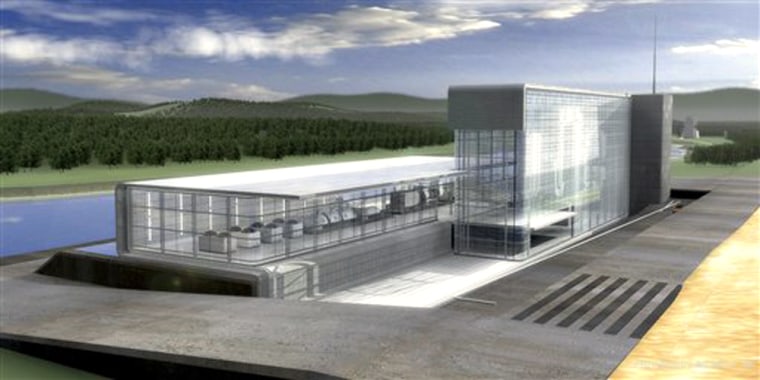In fierce bidding reminiscent of efforts two decades ago to win the superconducting super collider, seven states are aggressively trying to land a billion-dollar power plant prototype that's virtually pollution free.
Home to a third of the dozen sites chasing FutureGen, Illinois has up to $80 million in incentives on the table, from grants to low-interest loans. Ohio is offering twice that, while Texas has passed a law making it responsible for any legal entanglements stemming from the coal-fired plant's carbon dioxide emissions. Wyoming is offering incentives worth about $31 million and points out its coal to fuel the plant is cheaper than eastern coal.
"I think we have a substantial package," said Rob Hurless, energy policy adviser to Wyoming Gov. Dave Freudenthal.
Some of the states are ponying up everything from sales-tax relief to free land, pushing the enticements into the hundreds of millions of dollars in the hunt for more than 1,000 construction jobs and 150 permanent ones, along with the researchers and side businesses the plant should attract.
Did anyone mention the bragging rights?
"One of these sites ultimately will become known worldwide as the place where a new generation of zero-emission energy plants made its debut," Energy Secretary Samuel Bodman said recently after the 12 candidate sites were announced.
The finalists will be tapped this summer, with the winner to be announced next year — five years before the plant is expected to be running.
Touted as the power plant of tomorrow, FutureGen involves technology that converts coal into highly enriched hydrogen gas that burns cleaner than coal. Plans call for the 275-megawatt plant to capture most of its emissions of carbon dioxide _ a "greenhouse" gas widely blamed for global warming _ and inject them permanently into underground reservoirs, a process called sequestration.
A FutureGen alliance made up of a handful of coal and electric companies, including St. Louis-based Peabody Energy Corp., has committed more than $250 million to the project. The U.S. government is putting up about $700 million.
"It's a big deal," says John Grasser, spokesman for the Energy Department's Office of Fossil Energy. With two dozen states once inquiring about the project, for the victor "it's going to be an honor to have that science in that state."
The alliance's criteria have included a site's access to coal, water, rail lines, power transmission and underground geology that would allow permanent storage of carbon dioxide waste.
From there, states have sweetened the pot considerably.
Illinois is offering a $17 million grant to help pay for various project costs, as well as an estimated $15 million in sales tax exemptions on materials and equipment through local enterprise zones. The state also has set aside $50 million for below-market rate loans to the FutureGen alliance.
Additional property and sales tax abatements would be available at the four Illinois sites — Effingham, Marshall, Mattoon and Tuscola — pursuing the project.
"We believe we have a very good chance," says Andrew Ross, a spokesman for Illinois' Department of Commerce and Economic Opportunity.
So do other suitors.
Ohio is involved in two proposals. In one it joins with Kentucky and Pennsylvania to create a regional "coal consortium," meaning that if one of those states is a finalist the other two would support that state's bid. The second proposal would locate the plant in either Meigs or Tuscarawas counties in southeast Ohio, rich with recoverable bituminous coal.
Ohio's package of grants, low-interest loans and infrastructure support could total up to $164 million, says Mark Shanahan, chief of the Ohio Air Quality Development Authority, the lead agency in the project.
In Texas, which already has spent $2 million in choosing its two sites for the project, officials are offering $20 million to the FutureGen alliance for use on infrastructure or development.
Lawmakers there also recently passed a law indemnifying the alliance of any legal entanglements arising from the plant's carbon dioxide. As head of the state's FutureGen advisory board, Michael Williams believes that measure "moves Texas significantly ahead in the national competition for FutureGen because no other state has identified a suitable answer to this important question."
Texas has emerged victorious in duels like this before, having outbid Illinois and other states in the 1980s in snatching the super collider, what was to have been a 54-mile underground ring of magnets that would smash protons together.
Though scientists once hoped the $11 billion project would help unlock the secrets of matter and energy, it was just one-fifth complete when Congress pulled the plug on it in 1993 at a cost to taxpayers of $2 billion.
Texas had pledged $1 billion to that effort, which promised a payoff of 4,500 construction and 2,500 permanent jobs.
In bidding for FutureGen, West Virginia is offering 387 acres of state land for the site it has in play.
Wyoming is pitching more than $30 million in incentives — including sales and use tax exemptions — while providing 640 acres of land worth about $900,000.
In addition, Wyoming's proposal notes that C02 produced by the plant could be sold to oil companies that inject it underground to force more oil out of the ground.
North Dakota has not publicly revealed any of its enticements, and messages left with several agencies and officials involved in that recruitment effort went unreturned.
Kentucky's bid includes 215 acres of free land in Henderson County _ near an active coal mine and the confluence of the Green and Ohio rivers _ and $2.4 million in incentives.
